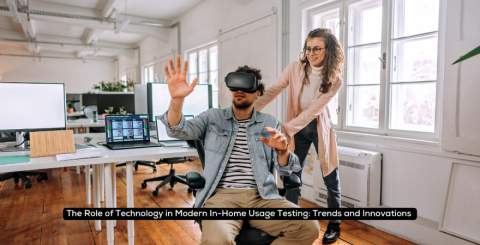The Role of Technology in Modern In-Home Usage Testing: Trends and Innovations

In today's fast-paced consumer market, understanding customer preferences and behavior is paramount for businesses to stay ahead of the curve. Enter in-home usage testing (IHUT), a game-changing strategy that empowers companies to gather invaluable insights directly from consumers in their natural environments.
Leveraging the latest technological advancements, modern IHUT studies are revolutionizing the way products are tested and refined, offering unparalleled opportunities for personalization, real-world integration, and comprehensive data collection.
The Evolution of In-Home Usage Testing (IHUT)
The rise of in-home usage testing (IHUT) has significantly transformed the traditional approach to product testing. This section explores the convenience and accessibility advantages of IHUT, as well as the pivotal role of technology in driving its evolution. Advancements from virtual and augmented reality to mobile apps and smart sensors have revolutionized the way products are tested and evaluated.
A. Convenience and Accessibility
Traditional product testing methods often required participants to attend in-person surveys or focus groups. However, the rise of in-home product testing has revolutionized this landscape by bringing unparalleled convenience and accessibility.
-
Convenience: Consumers can now test products in the comfort of their own homes, on their own schedule, and in their natural environment. This convenience leads to more accurate feedback compared to sterile testing facilities.
-
Cost Savings: Companies benefit from reduced costs associated with organizing in-person surveys and focus groups. Expenses like venue rentals and participant payments are minimized.
B. The Technology Shift
The integration of technology has been pivotal in driving the evolution of IHUT practices. Companies like Qualsights in home usage testing are pioneering innovative approaches to leverage cutting-edge technologies for more comprehensive and insightful IHUT studies.
Here are some key technological advancements:
-
Virtual and Augmented Reality (VR/AR): These technologies have transformed IHUT. Participants can virtually experience products, visualize their integration into daily life, and provide detailed feedback. For instance, a VR headset can simulate how a new kitchen appliance fits into a user's space, allowing for realistic testing.
-
Mobile Apps: Mobile apps enable seamless data collection during IHUT. Participants can log their experiences, take photos, and share real-time insights. App-based surveys and questionnaires enhance engagement.
-
Smart Sensors: IoT-enabled devices equipped with sensors capture usage patterns, duration, and context. Smart refrigerators, for example, track food consumption habits, helping companies refine product features.
Trends and Innovations
As IHUT continues to gain momentum, innovative approaches and trends are shaping the future of this field. This section delves into the personalization of testing experiences through AI algorithms and behavioral insights, the integration of longitudinal testing and smart home ecosystems, and the adoption of ethnographic approaches like observational studies and contextual interviews.
A. Personalization
-
Tailored Experiences: AI algorithms analyze user data to personalize testing scenarios, ensuring participants receive products aligned with their lifestyles for more relevant feedback.
-
Behavioral Insights: Smart devices track user behavior like sleep patterns and fitness routines, allowing companies to optimize designs based on real-world usage data.
B. Real-Life Integration
-
Longitudinal Testing: Extended testing periods, from weeks to months, reveal long-term product durability, usability, and satisfaction levels, uncovering issues that arise over time.
-
Smart Homes: IHUT within interconnected smart home ecosystems provides holistic insights into product compatibility, interoperability, and overall user experiences across multiple devices.
C. Ethnographic Approaches
-
Observational Studies: Researchers observe participants in natural settings, uncovering unanticipated usage patterns, pain points, and workarounds missed in controlled environments.
-
Contextual Interviews: In-depth conversations explore emotional connections and motivations behind product usage, helping companies better resonate with target audiences.
These trends, from personalization and real-life integration to ethnographic approaches, are revolutionizing IHUT, enabling companies to gather richer, more holistic insights into consumer behavior and develop products that truly resonate with their audiences.
Leveraging AI for Enhanced Insights
Artificial Intelligence (AI) has emerged as a powerful tool in enhancing IHUT practices. This section explores the role of Natural Language Processing (NLP) in sentiment analysis and topic modeling, as well as the application of Machine Learning (ML) models in predictive analytics and recommendation systems for personalized testing experiences.
A. Natural Language Processing (NLP)
1. Sentiment Analysis: NLP algorithms can accurately analyze vast amounts of consumer feedback, gauging overall sentiment as positive, negative, or neutral. This contextual understanding helps identify areas of satisfaction or concern to prioritize improvements.
2. Topic Modeling: Beyond sentiment, NLP techniques like topic modeling uncover recurring themes and topics within user feedback. This systematic analysis reveals specific pain points, standout features, and areas of interest, enabling targeted product refinements.
B. Machine Learning Models
1. Predictive Analytics: ML models analyze historical data to predict future product performance. By identifying potential issues early, companies can proactively address concerns before launch, minimizing risks.
2. Recommendation Systems: AI-powered recommendations enhance personalization by suggesting relevant products for testing based on individual preferences and behavior patterns. This tailored approach leads to more engaging and insightful testing experiences.
AI's ability to process vast data sets, discern patterns, and generate predictions is transforming IHUT. From sentiment analysis and topic modeling to predictive analytics and personalized recommendations, AI empowers companies to gather deeper consumer insights and develop products that truly meet customer needs.
Ethical Considerations in IHUT
As IHUT continues to evolve and embrace cutting-edge technologies, it is crucial to address ethical considerations. This section highlights the importance of privacy and data security through informed consent and anonymization, as well as the need for bias mitigation through algorithmic fairness and diverse participant selection.
A. Privacy and Data Security
1. Informed Consent: Clearly communicate data collection practices to participants, including the types of data being collected, the purpose, and how it will be used. Obtain explicit consent from participants, ensuring they understand the implications and have the freedom to opt-out without any consequences.
2. Anonymization: Implement robust anonymization techniques to protect user identities. This involves removing or obfuscating personally identifiable information (PII) from the collected data. Ensure strict adherence to privacy regulations, such as GDPR and CCPA, throughout the data lifecycle.
B. Bias Mitigation
1. Algorithmic Fairness: Regularly audit AI models used in IHUT for potential biases. Establish rigorous testing and evaluation frameworks to identify and address any unintended discrimination based on factors like gender, race, or age. Continuously monitor and update models to maintain fairness.
2. Diverse Participant Selection: Regularly audit AI models used in IHUT for potential biases. Establish rigorous testing and evaluation frameworks to identify and address any unintended discrimination based on factors like gender, race, or age. Continuously monitor and update models to maintain fairness.
By prioritizing ethical considerations, IHUT can foster trust, promote inclusivity, and drive responsible innovation while safeguarding privacy, upholding data security, and mitigating biases.
Comparison Table: Traditional vs. Modern In-Home Usage Testing
|
Traditional IHUT |
Modern IHUT |
|
Limited technology integration |
Leverages VR/AR, mobile apps, and smart sensors |
|
One-time, short-term testing |
Longitudinal testing over extended periods |
|
Minimal personalization |
Personalized experiences through AI algorithms |
|
Focus on product functionality |
Holistic insights into real-life integration |
|
Potential geographical limitations |
Global reach through remote testing |
|
Limited data collection methods |
Diverse data collection methods (e.g., sensors, apps) |
Frequently Asked Questions
1. What are the benefits of participating in an IHUT?
Early access to new products, ability to influence product development through feedback, potential compensation/incentives, and shaping products for better user experiences.
2. How is data collected and used during an IHUT?
Data collection methods include surveys, interviews, observational studies, and tracking user interactions via apps or sensors. Data is analyzed to gain insights into user behavior, preferences, pain points, and overall experience to optimize product design and usability.
3. What products are typically tested through IHUT?
IHUT is valuable for regularly used home products like appliances, electronics, personal care items, food/beverages, automotive, and home improvement products. It provides insights into long-term durability, usability, and satisfaction in real-world scenarios over extended periods.
Conclusion
Technology continues to shape IHUT, making it a dynamic field. As a content marketing researcher, staying informed about emerging trends and leveraging technology is crucial for enhancing testing practices. Embrace innovations like VR/AR, smart sensors, and AI models to gather richer, more contextual insights.
Remember, successful IHUT relies on striking a balance between cutting-edge technology and ethical practices. Prioritize privacy, security, and bias mitigation to build trust with participants and ensure meaningful results.
Similar Articles
You should maintain a clean and well-organized kitchen as it will lead to a healthier and happier life. In this respect, there are various convenient little aids, which come to the rescue in this matter.
When we think of home maintenance, we typically imagine spring and summer as the prime times to tackle repairs and upkeep. After all, the weather is warmer, the days are longer, and outdoor tasks seem far more manageable.
Explore modern facade design, including materials, sustainability, technology, and how facades shape building performance and visual identity.
Choose the right outdoor lighting color temperature to enhance your home’s siding, landscaping, and architecture, including tips for warm, cool, and daylight tones.
Discover what a funeral concierge is and how they help families with personalized guidance, planning, and support during end-of-life arrangements.
Learn how professional custom framing boosts art value and longevity. Get insights on frame styles, mounting, and protective techniques.
Boost drain cleaning efficiency with water jetters. Learn how high-pressure water systems remove tough clogs, reduce downtime, and protect pipes.
Picture this: you wake up scratching, spot a couple of weird red marks, shrug, and get dressed for work.
Here's the thing about building a custom home, it's probably the largest check you'll ever write, and yet so many people dive in without a solid game plan.









